Nature in Valcea
I am going to try something new with this blog post. Usually, when I go somewhere on vacation, the things that capture my attention are not what interest about anybody else in my entourage. I am also not a very lyrical writer, so what's the point of enumerating the places I've been from the perspective (oh, so much used!) of the casual tourist. I imagine myself writing one of those horrid "10 things to do in..." articles, promptly vomit and desist from thinking about it.
With this post, though, I am going to tell you of the wild (but accessible) area that I've explored and where to find it, how I felt and, if I can find the references, what plants and animals live there. You see, when I go somewhere, I avoid people and take really bad pictures of flowers and plants, butterflies, weird things and sometimes landscapes.
The place
I've been to Cheile Bistritei Valcene (the canyon of the river Bistritza from Valcea - there is another one in the north of the country) and in the valley of the Luncavatz river. The vegetation and insects are very similar, so I am going to treat this as a single area, even if their locations are 20 KMs apart:
- Cheile Bistritei: from 45.189828, 24.039859 to 45.197871, 24.030284
- Raul Luncavat: from 45.186682, 23.917856 to 45.190084, 23.914488
The area is very nice, easy to get to by car, but not very touristic yet, so not a lot of people having picnics and listening loudly to music. Leave your car and walk on the sides of the river(s) and the scenery is verdant and quiet. I have to warn you that even if in Romanian they are called rivers, they are more like creeks, especially at this time of the year. You can even find some caves in the area and if you are the long walk type of person, some 4-5 hour hike routes to more remote areas. Some flowers are white, but the vast majority of them are either yellow-orange or violet in color and probably are much more interesting in ultraviolet than human vision.
Animal life
I haven't seen any animals other than birds, a running lizard and a lot of insects.
I saw several species of butterflies, the most common by far being a medium sized orange with black spots, a fritillary, probably the Silver-washed fritillary (Argynnis Paphia) or mantia imparatului in Romanian. They were frolicking on these tall yellow flowers with large leaves: the yellow oxeye (Telekia speciosa) or brusture and ochiul-boului in Romanian. The next most common was a shy dark butterfly with a crimson edge on its wings. Probably the Woodland ringlet (Erebia Medusa), I have no idea what the Romanian popular name for it is.

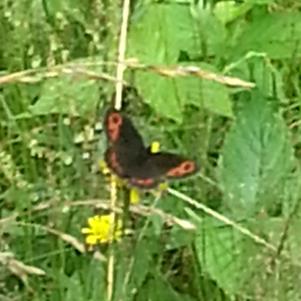
Some other butterflies: the cabbage white (Pieris rapae) or fluturele de varza in Romania, the peacock (Aglais io) or ochi de paun de zi in Romanian, the swallowtail (Papilio machaon) or coada de rindunica in Romanian and even one glimpse of what I think was a marbled white (Melanargia galathea) or tabla de sah in Romanian.
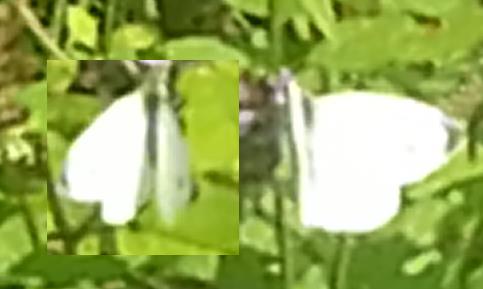
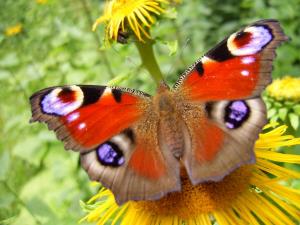
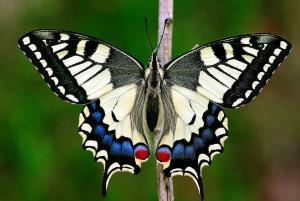
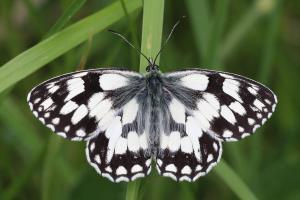
One fascinating specimen looked similar to a peacock butterfly from afar only for it to settle in a triangular black and white shape when it stopped. It must have been a moth! I've identified it as a Jersey tiger moth (Euplagia quadripunctaria) or fluturele urs dungat in Romanian.
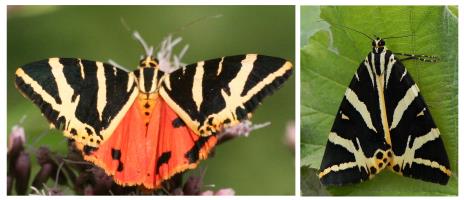
What I also found fascinating is a tree that had apparently been colonized by ants. A lot of wood dust was on the ground and a lot of activity was inside the trunk. Still, there was another hole in the trunk that was filled with wood dust, but no ant activity. Could it have been some sort of other factor, termites or perhaps a disease, that destroyed the tree trunk's interior and the ants were just opportunists?
Plants
Now, plants are easier to photograph, but harder to identify. I've mentioned the oxeye. Then there was the touch-me-not (Impatiens noli-tangere) or slabanog and bradulet in Romanian, which appears to have been used traditionally for its medicinal properties, mostly related to kidney or gynecological issues. The Spreading bellflower (Campanula patula) was there, together with its close relative, the Creeping bellflower (Campanula rapunculoides) - both are called clopotei in Romanian. There was the mountain geranium (Geranium robertianum) or napraznic and priboi and iarba sfintului Robert in Romanian, which appears to have anti-stress, anti-cancer and fertility related purposed in traditional medicine.
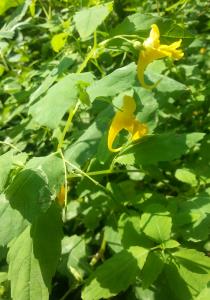
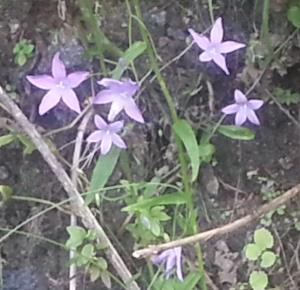
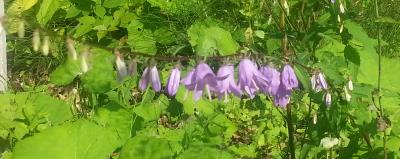
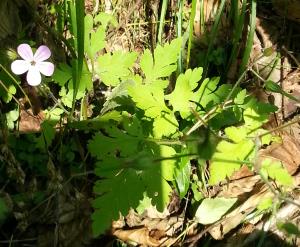
Field mustard was present as well (Brassica rapa). This plant was and is used for a variety of reasons in many cultures. The leaves and roots are rich in oil. In Puglia they use the buds as cimedirape in the making of orecchiette pasta. It is a plant from the cabbage family of plants, probably explaining the presence of the cabbage butterflies.
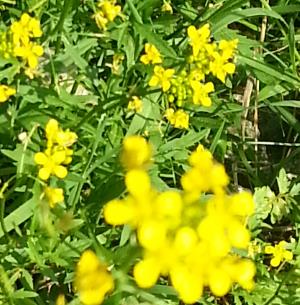
A very interesting flower has a very weird name: the Viper's bugloss (Echium vulgare) or iarba sarpelui in Romanian. It has blue flowers but the filaments of the stamens are red, contrasting with the petals and giving it a violet color per whole. It has medicinal uses as well, as an antidote for snake bites and for its antibiotic and astringent properties.
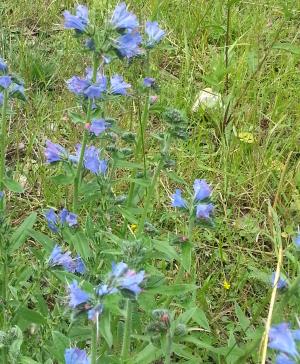
Another violet flower, with uses in homeopathic medicine but also in poisonings, is aconite or wolfsbane (Aconitum napellus) or omag in Romanian. It contains powerful alkaloids and at one time it was forbidden to grow this plant anywhere in the Roman Empire on penalty of death. Death from intoxication with the plant can occur in as little as half an hour!
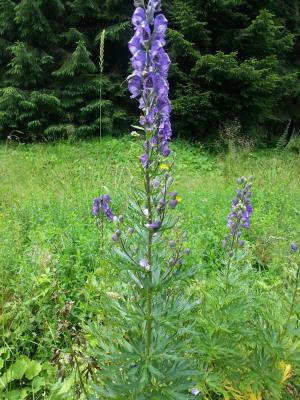
And since we are talking about a violet flower with medicinal properties, how can we ignore the heal-all (Prunella vulgaris) or busuioc salbatic in Romania. The young leaves and stems can be eaten raw in salads; the plant in whole can be boiled and eaten as a potherb; and the aerial parts of the plant can be powdered and brewed in a cold infusion to make a beverage and it is used as an astringent in folk medicine.
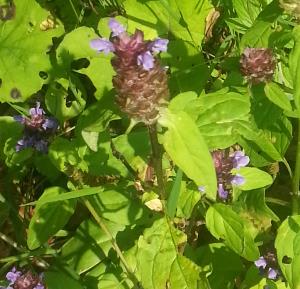
Not often, but when it happened it was a whole field of them, I found the Orange mullein (Verbascum phlomoides) or luminarica in Romanian. It is also a medicinal plant, used for the calming, sweat inducing and expectorant effects.
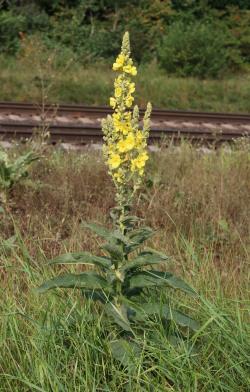
I've seen some daisies in the area and also another flower from the same family: the fleabane (Erigeron annuus) or bunghisor in Romanian. Used in salads as well as against the common cold or stomach aches in folk medicine.
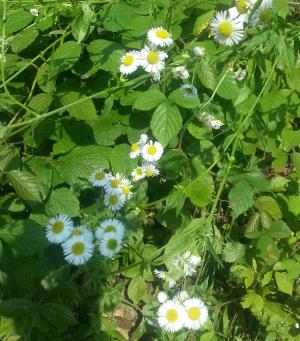
Last, but not least, the evening-primrose or sundrop (Oenothera biennis) or luminita noptii in Romanian. It started as an American plant, much like the fleabane, but it was brought and naturalized in Europe. It has been used medicinally by the native Americans for all kinds of ailments, as it is an edible plant containing an oil with anti inflammatory properties.
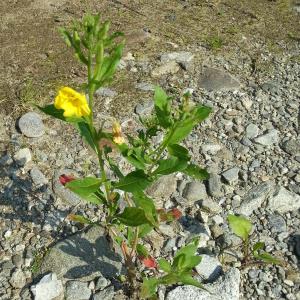
There were a lot of plants without flowers, but I haven't had the time or patience for them. There was one with huge leaves and I photographed it for identification purposes. It turns out it was either the butterbur (Petasites hybridus) or the burdock (Arctium lappa) both called brusture in Romanian, but different species altogether. It's probably the Arctium, but I can't be sure!
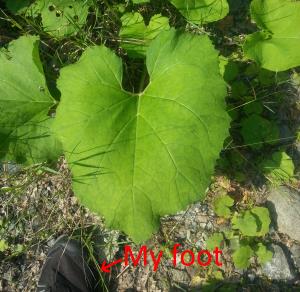
Resources
It would have been a lot more difficult for me to write this post if it weren't for sites like:
- Pl@ntNet - upload photos of plants and get an instant AI driven identification
- Butterfly Conservation - a comprehensive list of common butterflies
- Butterflies from Romania - from a blogger brother (Cătălin Murgocea)
- Revista Radio Guerrilla → Casca de cultură → Insectar - not expecting that there, but high quality stuff and a lot of passion
- ... and of course Wikipedia and Google, which will let me find the correct association between a Latin name and the regional names
Even with these great resources, it was obvious that not many people will publish nature related posts in any systematic manner. Even this post, three hours in the making, is a random mess of blurry pictures and random observations.
Comments
This year I used Plantnet myself, after years of wondering "what is the name of this?" over and over again. I would have preferred automatic Romanian translations of the Latin names. Probably a future feature. A friend commented that she searched years before for the names of the encountered plants in the botanical atlas at home, no phone camera and app in sight or needed. Maybe enhanced reality glasses for nature names and patterns will make some of us more connected and respectful towards Nature. Nice post, thanks for sharing your effort. Best regards :)
Ion Motica